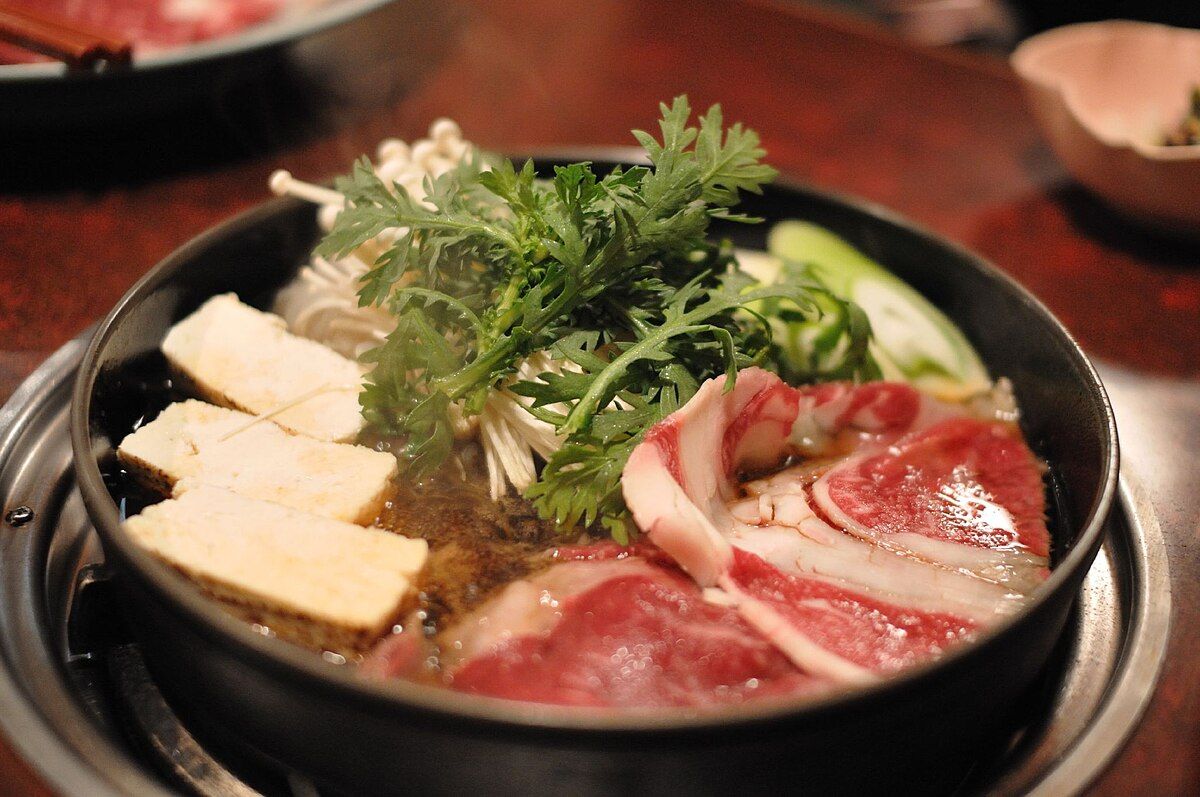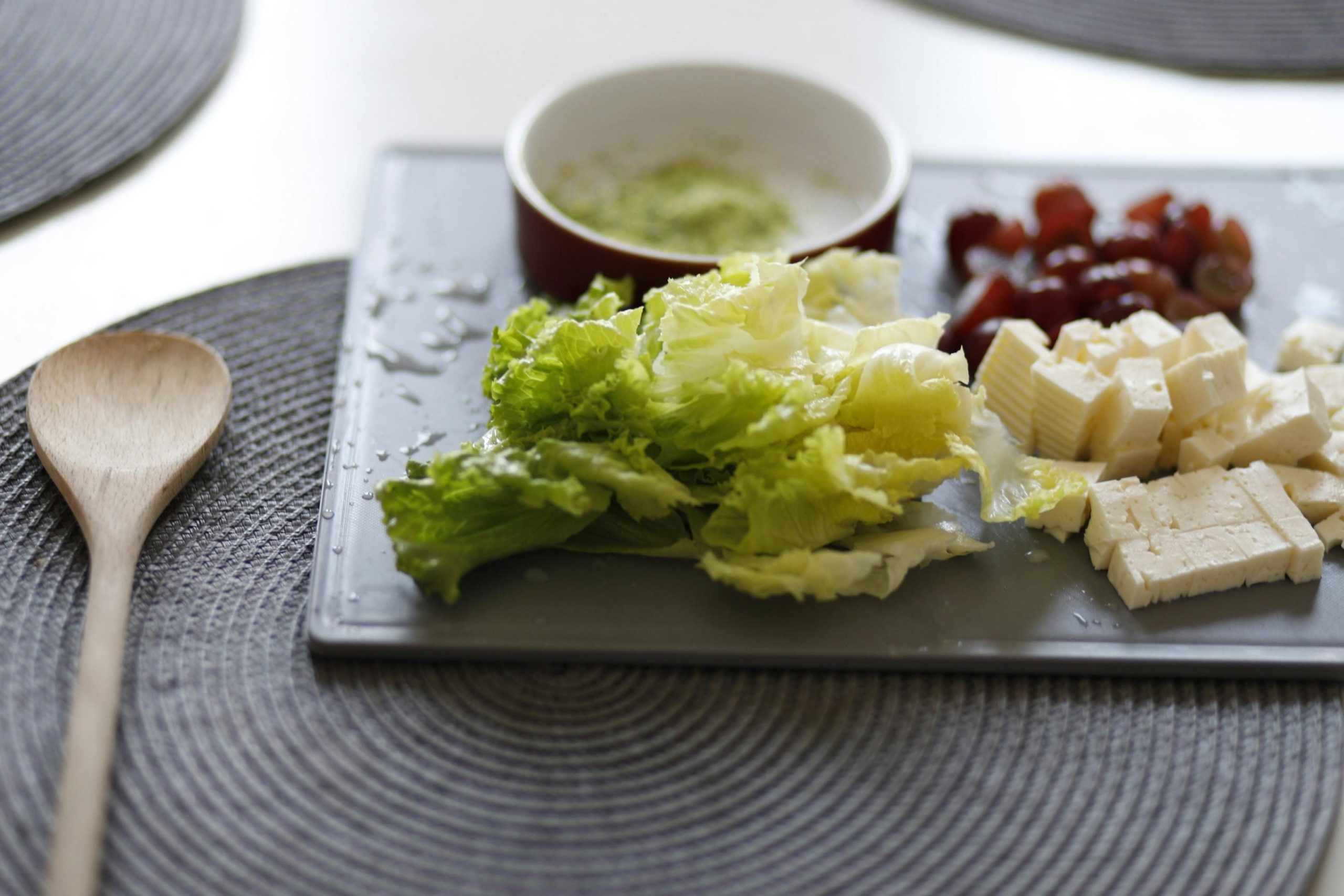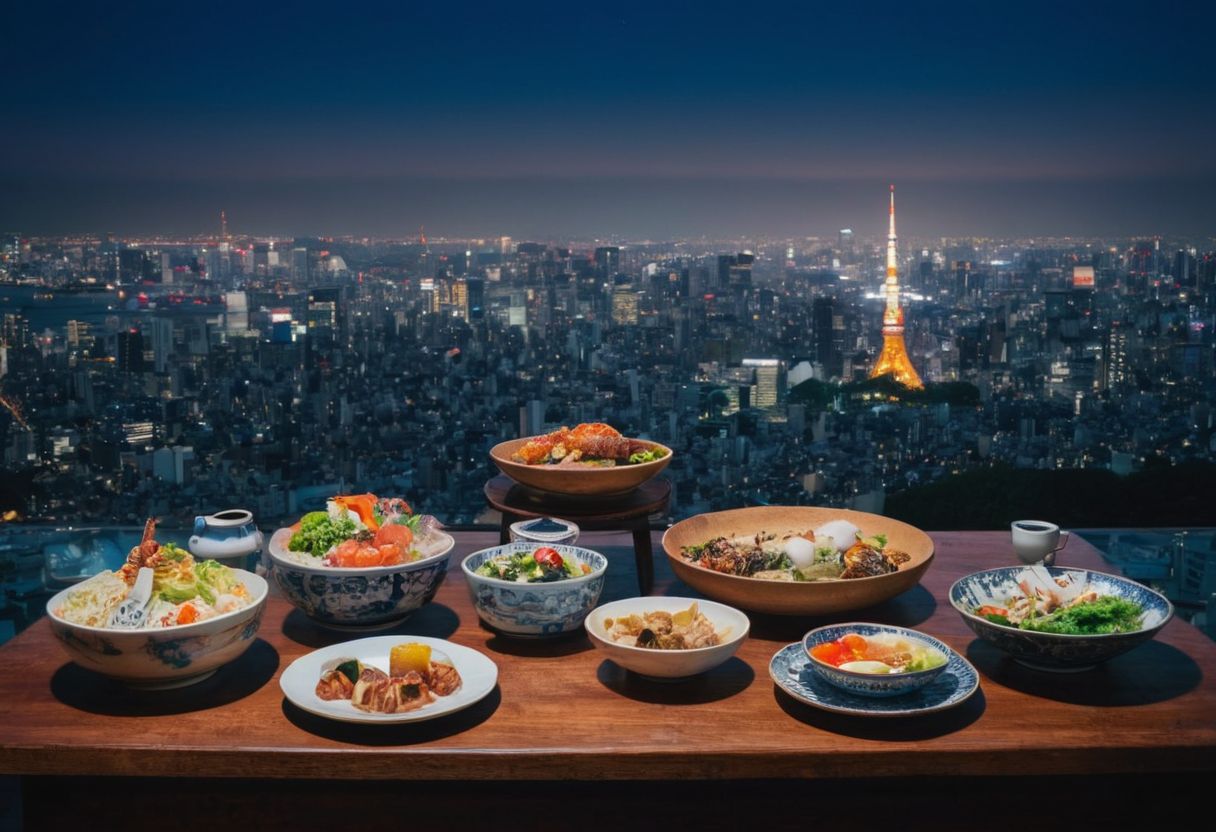Have you ever wondered what makes sukiyaki a beloved Japanese hot pot dish?
Finding a dish that perfectly balances flavor, tradition, and versatility can be a challenge.
Sukiyaki is a flavorful Japanese dish where thinly sliced beef, vegetables, and other ingredients are cooked in a sweet and savory sauce made from soy sauce, sugar, and mirin.
In this ultimate guide, we’ll explore everything from the basics and history of sukiyaki to regional variations, essential ingredients, and the art of enjoying this delightful dish.
What is Sukiyaki? Understanding the Basics

Sukiyaki is a traditional Japanese dish that is both a culinary delight and a unique dining experience. It consists of thinly sliced beef, which is often Wagyu due to its tenderness and flavor, combined with a variety of vegetables like mushrooms, cabbage, and tofu. These ingredients are cooked in a distinctive sweet and savory broth made from soy sauce, sugar, and mirin. This combination of ingredients not only provides a rich flavor profile but also a balanced meal that includes protein, vegetables, and a delightful broth.
What sets sukiyaki apart from other dishes is its method of cooking and serving. Sukiyaki is typically prepared at the table, where diners can cook the ingredients to their liking in a communal pot. This style of dining is not just about eating; it’s about engaging with friends and family, making it a deeply communal and interactive experience. The ingredients are dipped into a beaten raw egg before eating, which adds a creamy texture and cools the ingredients slightly, enhancing the overall flavor of the dish.
The Historical Journey of Sukiyaki
Sukiyaki’s journey through Japanese history is as rich and layered as the dish itself. Originating during the Meiji Era when Japan opened to Western influences, sukiyaki symbolized a significant cultural shift as beef consumption became more common among the Japanese. This shift was not just culinary but also a reflection of broader social changes, as Japan moved from isolation to a more open exchange with the world. The dish’s evolution continued as it became a popular choice for communal gatherings like year-end parties, known as bonenkai.
However, the historical path of sukiyaki wasn’t without its hurdles. During and after World War II, Japan faced a beef shortage, causing sukiyaki to fade temporarily from popular cuisine. But, as Japan recovered and entered a period of economic prosperity, sukiyaki made a comeback, reestablishing itself as a cherished dish in the Japanese culinary scene. Today, sukiyaki holds a special place in Japan’s gastronomic tradition, celebrated for its rich flavors and communal dining experience.
Regional Variations: Kansai vs. Kanto Sukiyaki
Sukiyaki varies notably between the Kansai and Kanto regions of Japan, each offering a unique take on this beloved dish. In Kansai, the process starts with grilling the meat, which is then seasoned with sugar and soy sauce. This method highlights the flavor of the meat first before other ingredients join the pot. The Kansai approach is distinct in its layering of flavors, adding vegetables and other ingredients only after the meat has been savored.
Conversely, Kanto-style sukiyaki presents a harmonious mix of meat and vegetables right from the beginning. The ingredients are cooked together in a special broth called warishita, made from soy sauce, mirin, sugar, and dashi. This method ensures that the flavors of the meat and vegetables meld seamlessly, creating a rich, unified taste throughout the dish. The Kanto style is celebrated for its ability to distribute the umami flavors evenly, offering a different, but equally engaging sukiyaki experience.
Choosing the Right Beef for Sukiyaki

When selecting beef for sukiyaki, quality and marbling are key. The preferred choice is well-marbled beef such as Wagyu, known for its rich flavor and tender texture. The fat marbling melts into the beef slices as they cook, infusing the dish with a delicious, buttery taste that enhances the overall flavor of the sukiyaki.
For those looking for specific cuts, ribeye or chuck are excellent options for their balance of meat and fat. If you’re shopping at a Japanese grocery, look for packages labeled “sukiyaki beef,” which are pre-sliced to the ideal thickness for cooking. Remember, the right beef will not only elevate the taste but also ensure that each bite is tender and full of the traditional Japanese beef hot pot essence.
Mastering Warishita: The Art of Sukiyaki Sauce
To start crafting the traditional sukiyaki sauce, known as Warishita, you’ll need to gather a few key ingredients: soy sauce, sake, mirin, and sugar. Begin by combining ½ cup soy sauce, ½ cup mirin, and ½ cup sake in a saucepan. This trio of ingredients forms the base of your sauce, providing a balance of savory, sweet, and umami flavors that are essential to Warishita.
Next, add one tablespoon of sugar to the mixture, adjusting the amount based on your taste preference for sweetness. Heat the mixture over medium heat, allowing the alcohol from the sake and mirin to evaporate, which should take about a minute. Stir continuously until the sugar is fully dissolved. This process ensures that your Warishita achieves the perfect consistency and flavor, making it an indispensable part of the sukiyaki experience.
Essential Ingredients and Substitutions for Sukiyaki
Sukiyaki thrives on a blend of specific ingredients that contribute to its unique taste. Traditionally, this includes thinly sliced beef, napa cabbage, Tokyo negi (or other long green onions), and a variety of mushrooms like shiitake and enoki. Tofu, either grilled or firm, and shirataki noodles are also essential for adding texture and absorbing the rich flavors of the sukiyaki sauce.
For those who need to make substitutions, there are plenty of options that maintain the dish’s authentic flavor. Instead of Tokyo negi, leeks or standard green onions can be used. If shirataki noodles are hard to find, glass noodles or even thin spaghetti can offer a similar texture. For a vegetarian version, increase the amount of mushrooms and tofu, or use meat substitutes to replicate the texture of beef.
How to Cook Sukiyaki: Techniques and Tips

The traditional method of cooking sukiyaki involves using a cast-iron pot, which is essential for achieving the distinctive taste and texture of the dish. Begin by heating the pot on medium-high heat at the dining table, allowing diners to participate in the cooking process. First, grease the pot slightly with oil or suet, then lay down the well-marbled beef slices to sear, creating a rich, caramelized base.
After the beef has been seared, it’s time to add the other ingredients in sequence. Start with the hardest vegetables that take longer to cook, such as carrots and Tokyo negi, followed by softer items like Napa cabbage and mushrooms. Pour the warishita (sukiyaki sauce) over the ingredients, ensuring they are just partially submerged, and allow everything to simmer together, melding the flavors into a harmonious blend. This method not only cooks the ingredients but also enhances their taste by soaking up the savory broth.
Enjoying Sukiyaki: Serving and Eating Etiquette
Sukiyaki is traditionally served in a communal pot, placed at the center of the dining table, fostering a shared experience among diners. Each person at the table cooks their chosen ingredients in the pot, which simmers with the delicious warishita sauce. The common etiquette is to use your own set of chopsticks to pick up the ingredients from the pot and transfer them to your bowl. It’s important to wait until everyone is ready and to avoid overcrowding the pot, ensuring all ingredients cook evenly.
Once the ingredients are cooked, they are typically dipped into a bowl of raw beaten egg before eating. This not only cools the food slightly but also adds a silky, rich texture to the dish. Here are some key points to remember:
- Always use a separate set of chopsticks for dipping into the communal egg to maintain hygiene.
- Do not dip the entire ingredient; just a quick dip to coat it lightly is customary.
- Be mindful of others and ensure everyone gets a fair share of the ingredients and sauce.
Sukiyaki vs. Shabu Shabu: A Culinary Comparison
While both sukiyaki and shabu shabu are cherished Japanese hot pot dishes, they differ significantly in preparation and flavor. Sukiyaki is known for its rich, sweet broth made from soy sauce, sugar, and mirin, where all ingredients are cooked together, emphasizing a deeper flavor infusion. In contrast, shabu shabu features a lighter, clear broth, typically made from kombu, and ingredients are cooked individually, swished piece by piece in the boiling broth.
The experience of eating these dishes also varies. Sukiyaki often involves dipping cooked ingredients into raw beaten egg, enhancing the meal’s richness. On the other hand, shabu shabu offers a variety of dipping sauces, such as ponzu and sesame sauce, which complement the subtle flavors of the shabu shabu beef and vegetables. Both dishes provide a communal dining experience, but their distinct broths and dipping options set them apart in the Japanese culinary landscape.
Dishes Related to Sukiyaki: Exploring Similar Flavors
Exploring Japanese cuisine beyond sukiyaki introduces a variety of similar dishes that share its savory and sweet flavor profile. Shabu-shabu, for instance, is another popular hot pot dish, featuring thinly sliced meat like beef or pork that is swished in a light broth and often dipped in ponzu or sesame sauce. Both sukiyaki and shabu-shabu use thinly sliced meats and emphasize communal dining, but their broths and dipping sauces differ, offering unique taste experiences.
Another dish akin to sukiyaki is Nabemono, or simply ‘nabe’, which refers to a range of Japanese hot pot dishes. These include:
- Chanko nabe, the hearty sumo wrestler’s stew, which combines a variety of meats and vegetables in a rich broth.
- Yosenabe, which means ‘everything in a pot’, mixing seafood, meats, and vegetables in a miso or soy sauce broth.
Like sukiyaki, these dishes are perfect for social gatherings, allowing diners to cook their selection of ingredients in a shared pot.
Discover Sukiyaki and More with Indulge Culinary Tours
If you’re captivated by the rich flavors and history of sukiyaki, consider elevating your culinary journey with INDULGE’s curated food tours in Zurich. These tours not only introduce you to Swiss specialties but also immerse you in international cuisines, including Japanese delights like sukiyaki. By participating, you’ll benefit from:
- Expert guidance from local chefs and food connoisseurs
- Exclusive insights into the culinary history and techniques
- A unique, immersive experience that goes beyond typical dining
Embark on a gastronomic adventure with INDULGE and discover the art of sukiyaki and more through their expertly guided tours.
Frequently Asked Questions
What is sukiyaki in Japan?
Sukiyaki is a traditional Japanese dish that features thinly sliced beef, vegetables, and other ingredients cooked in a sweet and savory broth made from soy sauce, sugar, and mirin. It’s known for its rich flavor profile and is typically prepared at the dining table in a communal pot, allowing diners to cook the ingredients to their liking. This method of dining enhances the communal and interactive experience, making sukiyaki a beloved culinary delight in Japan.
What’s the difference between shabu shabu and sukiyaki?
Sukiyaki and shabu shabu are both popular Japanese hot pot dishes but differ in preparation and flavor. Sukiyaki is known for its rich, sweet broth made from soy sauce, sugar, and mirin, and ingredients are cooked together, emphasizing a deeper flavor infusion. Ingredients are typically dipped into raw beaten egg after cooking. Shabu shabu features a lighter, clear broth, typically made from kombu, and ingredients are cooked individually and swished piece by piece in the boiling broth, served with dipping sauces like ponzu and sesame sauce.








